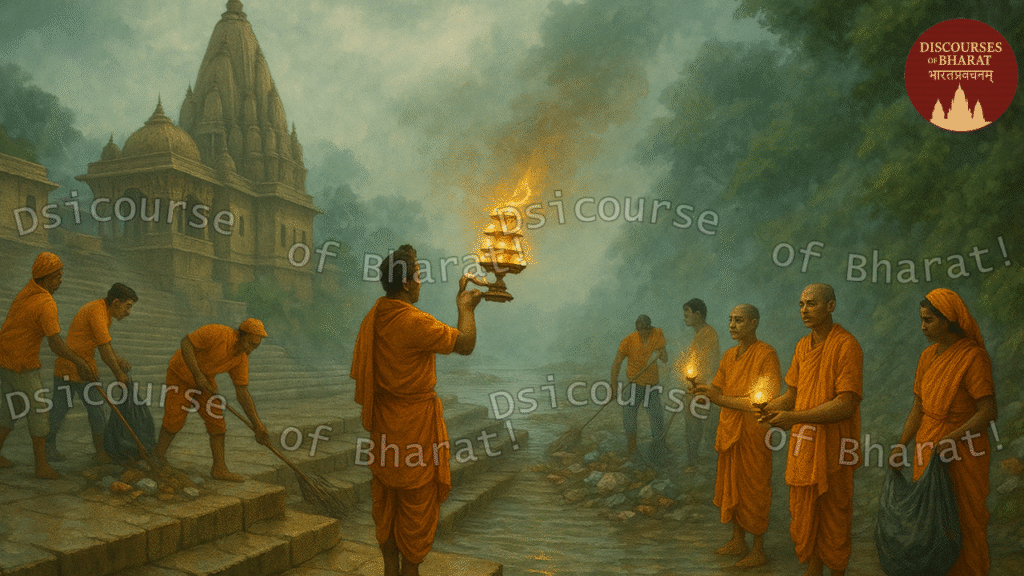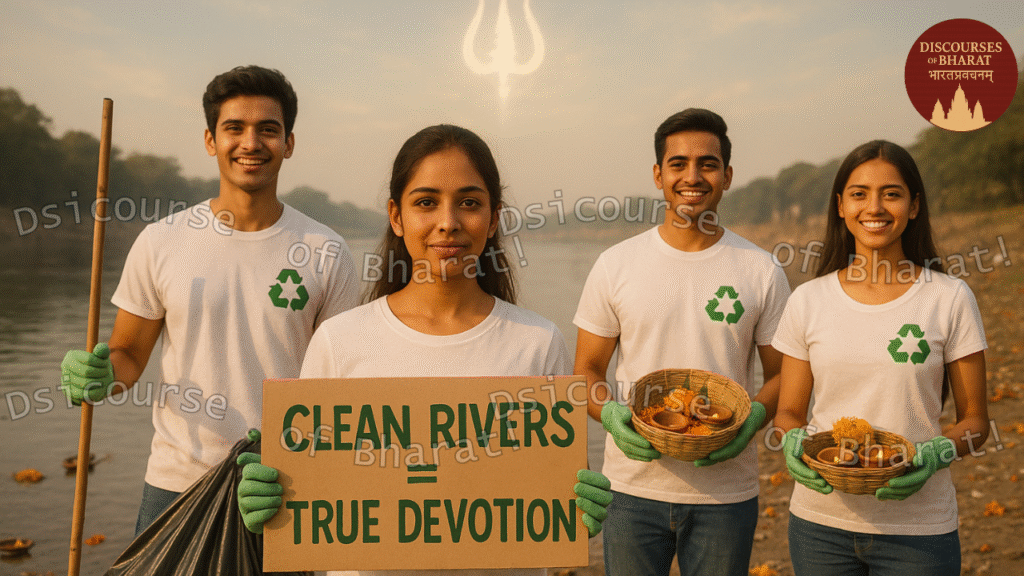Shravan month 2025: We Indians take pride in the culture of Bharat, and Bharat is Hinduism. That’s why we call it Hindustan. Currently, we are celebrating the holy month of Shravan. Many of our mothers, wives, daughters—even some men—are fasting every Monday and praying to Lord Shiva to show Lord Shiva devotion. However, are we doing him justice?

The sacred Ganga flows from Lord Shiva’s braids to our Earth, purifying us and offering a path to attain moksha after death. Yet today, this very Ganga is being polluted by our own hands. Can we truly call ourselves devotees of Lord Shiva? It’s not just the Ganga river pollution, but her sisters—Yamuna, Narmada, Saraswati, Godavari, and Kaveri—that we have polluted, misused, and neglected. Is this what Sanatan Dharma has become in the modern era?
How can Lord Shiva bless us or our nation when we fail to respect his divine gifts? This article is a heartfelt call to awaken the younger generation and remind them of the spiritual, ecological, and cultural importance of India’s rivers. Let us raise our voices for the rivers that are crying for help.
The Spiritual Importance of Rivers in Hinduism
The rivers of India have never been seen as just water bodies. In Hinduism, they are divine mothers, goddesses, and a direct source of spiritual energy.
- Ganga is revered as a purifier, flowing from the jata (locks) of Lord Shiva to cleanse the sins of humanity.
- Yamuna is celebrated as a symbol of divine love, especially associated with Lord Krishna.
- Saraswati, though now invisible, is seen as a mystical river that carries the essence of knowledge and wisdom.
- Narmada and Godavari, too, hold sacred significance, often said to grant salvation to those who bathe in them.

In rituals such as Jalabhishek, Snan, and Tarpan, river water is central. It’s not just a symbolic act—it’s an invocation of divine presence. Scriptures like the Rig Veda, Ganga Lahiri, and Skanda Purana speak of rivers as mothers and goddesses. The Mahabharata even notes that bathing in these rivers with a pure heart can absolve lifetimes of sins.
Also Read: Discover Hariyali Teej 2025
The Grim Reality: Pollution, Plastic, and Urban Decay
Despite their divine status, the current state of India’s rivers is a spiritual and environmental tragedy.
According to a recent CPCB (Central Pollution Control Board) report, large stretches of the Ganga in Varanasi and the Yamuna in Delhi are filled with toxic foam, industrial effluents, sewage, and ritual waste. Shravan, a month that should bring sacred waters and purity, ends up becoming a period where pollution doubles due to the massive dumping of puja items, flowers, plastics, and ashes.
Sand mining, shrinking riverbeds, dying tributaries, and unregulated industrial discharge have pushed many rivers to the brink of death. Riverbanks that once hosted divine energy are now surrounded by filth and decay.
This isn’t just an environmental concern—it’s a spiritual emergency. We say “Ganga Mata ki Jai,” but our actions scream disrespect. We are all responsible for the river pollution in India.
A Call for Bhakti With Responsibility
True devotion isn’t just lighting a diya—it’s living by the values of dharma. It’s time to transition from symbolic bhakti to sustainable bhakti.

- Namami Gange, an ambitious central government program, is making strides in cleaning the Ganga. But it cannot succeed without people’s support.
- Local initiatives by youth groups, NGOs, and residents in towns like Rishikesh and Allahabad have shown that community river cleanups work.
- The use of eco-friendly puja samagri, biodegradable packaging, and limiting the immersion of non-natural items in rivers is slowly becoming popular.
Even spiritual leaders like Sadhguru, Sri Sri Ravi Shankar, and Swami Avdheshanand Giri have emphasized that “cleanliness is next to godliness.” They urge followers to protect the environment as an act of seva (service).
Devotion should not pollute. Instead, it should preserve, purify, and protect.
Shravan Month 2025: As the Month of Water Worship — Let’s Protect What We Worship
This Shravan, let’s do more than fast and pray. Let’s act.
- Plant a tree near a riverbank or sacred pond.
- Educate others on the importance of not throwing plastics or chemical-laden offerings in rivers.
- Organize or participate in a local cleanup drive.
- Tag campaigns like #ShravanSankalp, #RiverIsMother, and #BhaktiWithConscience on Instagram and create awareness.
- Support brands and shops that sell eco-puja kits.
These are small acts, but if done with love and unity, they become a form of powerful worship.
Author’s Thought
Shravan month 2025: As you have already read all of these things, I would repeat my statement that I mentioned at the start: if we continue walking the path we are on and pollute our holy rivers, then we will be left with no place to attain Moksha, nor would we have the right to celebrate Shravan because Lord Shiva would not only ignore our Lord Shiva devotion, but also us.
This is the time when the youth, the Gen Z, wakes up and takes the initiative to not only ask the government, but also ask the people to keep the water clean. Start campaigns on social media; if needed, post the people who are polluting the river so they can be fined and taught a lesson. I would love for people to start an Instagram campaign and share the post with us by tagging us on Instagram @discoursesofbharat
BY – Zingsid
Jai Shiv Shambho! Jai Maa Ganga! Jai Bharat!

